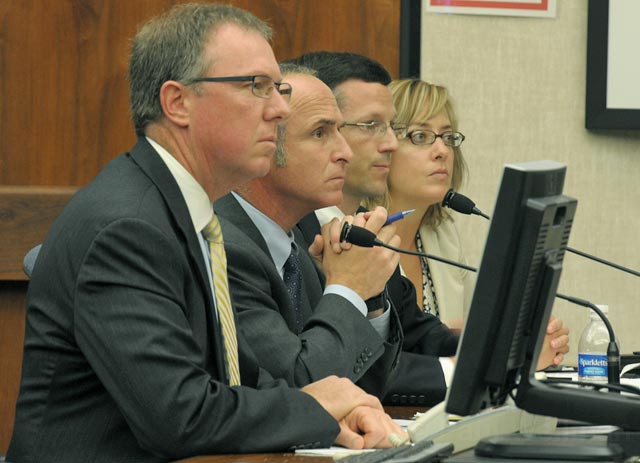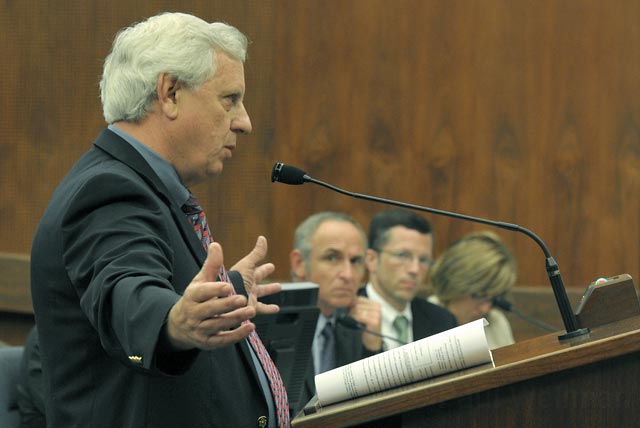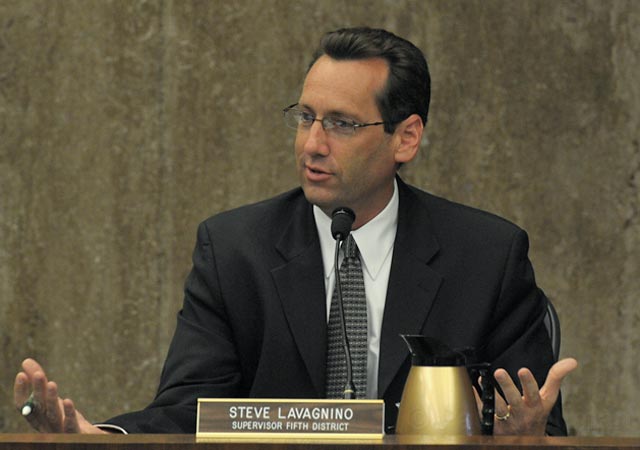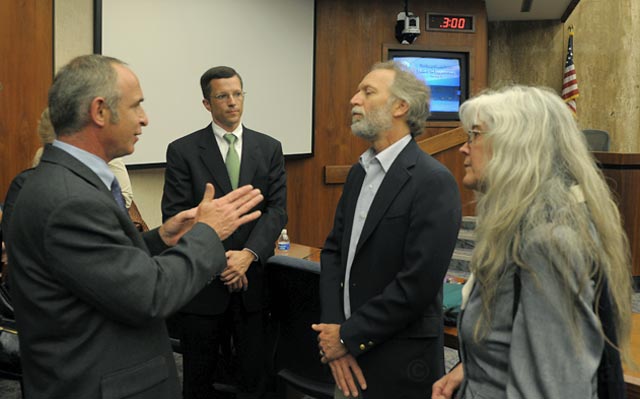Diablo Canyon Safe, Say Nuclear Regulators
County Supes Express Lots of Doubt, Concern, Skepticism

A team of three officials with the Nuclear Regulatory Commission (NRC) met with the Santa Barbara County Supervisors for two hours June 16 in hopes of persuading them that the Diablo Canyon nuclear power plant, operated by PG&E nearly 100 miles to the north in Avila Beach, was operated safely and posed no threat.
Like all nuclear plants on U.S. soil, Diablo has been subjected to two special inspections since the March 10 catastrophe at Japan’s Fukushima nuclear power plants, explained Anton Vegel, director of NRC’s Region IV Division of Reactor Safety. Those inspections, he said, found, “overall, no safety-significant issues.” Should Diablo Canyon be hit with a 7.5 magnitude earthquake—the largest federal authorities feel is possible given the region’s geology—Vegel said, “We have the resources and procedures to safely shut down.”
A month ago, a battery of spokespersons from PG&E sought to provide the supervisors with similar assurances. But neither presentation came close to succeeding in that effort. Three of the supervisors—Salud Carbajal, Janet Wolf, and Doreen Farr—voiced grave, and at times pointed, skepticism about the safety precautions in place and whether the NRC is sufficiently independent of the industry it regulates to really protect the public.
Furthermore, they pointed out, similar assurances had been made regarding the safety of the Fukushima plants by all the industry experts and international nuclear power authorities—and look what happened. They sought to impress upon the federal regulators that what happens at Diablo Canyon won’t stay at Diablo Canyon in the event of a nuclear accident. Airborne radiation will blow downwind with profound consequences for the health and safety of Santa Barbara residents, crops, property values, and, of course, the tourism industry.
“I’m not one of those individuals who are paranoid and think our government is plotting to get us,” said supervisor Carbajal. “But if there’s one agency that gives great cause for concern, it’s the NRC.” Given the potentially devastating stakes involved should something go wrong at a nuclear facility, Carbajal continued, “It gives us all the heebie-jeebies.”
The debate over safety at Diablo Canyon is driven by more than the recent near-meltdown of the Fukushima plants. Even before the massive earthquake-and-tsunami combo hit with such devastating violence, Diablo Canyon was in the cross hairs of anti-nuclear activists and key elected officials representing the Central Coast. Fueling concern recently was the 2008 discovery of a new fault line located just 300 yards off the coast from the Diablo Canyon power plant, coupled with PG&E’s stated intent to initiate re-licensing applications for the its two reactors 13 and 14 years before their existing licenses for the reactors expire. According to the initial timeline drawn up by PG&E, and embraced by the NRC, new studies on the seismic threat posed by the new fault—dubbed Shoreline Fault—would not be completed until after the re-licensing application process was completed.
Longtime critics of Diablo Canyon—like Mothers of Peace and the Alliance for Nuclear Responsibility—cried foul, insisting that the re-application process should be put on ice pending completion of the new seismic studies. Joining them in this were Republican State Senator Sam Blakeslee, who represents San Luis Obispo County in the state legislature and holds a Ph.D. in offshore earthquake geology, and Santa Barbara’s Democratic Congressmember Lois Capps. PG&E denied accusations it was in a hurry to get re-licensed before the new seismic studies could be completed. The company insisted its timing was driven by state regulatory agencies and their quest for accurate data on future energy supplies for planning purposes.

Until only recently, the NRC has steadfastly maintained that the re-licensing application could and should proceed independently of the new seismic studies information. At issue during re-licensing, NRC spokespersons have repeatedly stated, is the age and safety of the plant’s equipment and infrastructure. Seismic issues, they said, were of such importance that they were constantly reviewed on an ongoing basis. But in light of the Fukushima nightmare and the political heat that’s generated (joining Capps and Blakeslee now are U.S. Senators Diane Feinstein and Barbara Boxer, not to mention the San Luis Obispo County Board of Supervisors) PG&E and the NRC have embraced a limited, if tactical, retreat. Under the latest plan, the NRC will hold off making any final recommendation on re-licensing the two Diablo Canyon reactors until the new high-tech 3-D seismic studies are completed.
In his remarks to the supervisors, the NRC’s Anton Vegel pointed out that there are 200 staff members in the Region IV office focused on ensuring that California’s two plants—and four reactors—are run safely. In 2010, he said, more 3,600 staff hours had been spent by members of his office inspecting Diablo Canyon alone. While he faulted plant managers for lacking “a depth of problem evaluation in some cases,” he said the plant was well run.
Recent studies submitted by PG&E geologists this January reported that the plant is built to withstand whatever the local seismological conditions dish out. Diablo Canyon was engineered to withstand the ground motion inflicted by 7.5 quake originating at the Hosgri Fault. However, Vegel failed to note that PG&E’s recent studies downgraded the maximum punch Hosgri is capable of delivering to a 6.5. Company geologists have also presented reports indicating the new Shoreline fault is capable of far less. This assertion has been challenged by geologists with the United States Geologic Survey, who contend not enough is known about the new fault to say with any certainty what kind of ground acceleration it is capable of causing. To fill in these gaps, PG&E has begun seeking the regulatory approvals to begin conducting such tests.
Furthermore, Vegel pointed out that Diablo Canyon is perched on a coastal bluff 85 feet higher above the ocean. The maximum credible tsunami risk, he said, was only 35 feet. In addition, he said, the NRC stations two full-time inspectors at each reactor site throughout the United States to further ensure the highest safety standards.

For the supervisors, all this sounded good, just not quite good enough. Carbajal, Wolf, and Farr pointed out that Santa Barbara’s onshore oil industry too is regularly subjected to inspections and enforcement actions; and that Greka Oil nevertheless has a long history of spills. (They alluded to Greka without ever mentioning the company by name. Since the Thursday meeting, the federal government has filed civil charges against Greka for its shoddy environmental safety record.) Supervisor Steve Lavagnino, representing Santa Maria, was the least outspoken, suggesting that for foes of nuclear power, there was little the NRC or that PG&E could hope to do that would satisfy their concerns.
But Lavagnino also wondered what would happen if the area was hit by a quake bigger than 7.5. “Does that mean it [Diablo Canyon] fails at 7.6?” he asked. The question is relevant because the quake that rocked Fukushima registered 9.0, though geologists were of the belief that the seismological conditions were capable of generating a quake no bigger than 7.9. Farr expressed concern about how imprecise the current understanding of the Fukushima site remains even though it’s been three months since the disaster. Carbajal expressed serious concern that the there wasn’t sufficient independent peer review of the scientific basis on which the NRC and PG&E based their assurances about Diablo Canyon.
Supervisor Wolf hammered at PG&E’s resistance and reluctance to pursue the new seismic studies. PG&E opposed legislation introduced in 2009 that would have required such tests and that would have linked the results to Diablo Canyon’s re-licensing application. While PG&E has started some of the lower-level seismic studies, it has yet to begin the more sophisticated and scientifically demanding studies. The company is currently seeking approval from the California Public Utilities Commission to pass the costs of such studies on to the ratepayers. When a PG&E spokesperson said he could not say whether the company would initiate such studies without funding approval from the PUC, Wolf said she found this lack of commitment very troubling.

While most members of the public who spoke at the meeting were overwhelmingly critical of nuclear power and Diablo Canyon, David Cross of the Santa Maria Economic Commission said the utility company provided thousands of high paying jobs—the average salary being $92,000. Hundreds of the company’s workers, he said, lived in Santa Maria, contributing millions of dollars a year to the Santa Maria economy. A woman from the Santa Maria YMCA praised PG&E as a generous corporate citizen, and Andy Caldwell of COLAB objected to the presumption of guilt to which PG&E had been subjected. “We wish people would treat PG&E with more respect,” he said, “not like criminals, sloppy in their work and needing to be overseen.”
Brian Rosen, an anti-nuke crusader, suggested that far more energy could be provided by conservation and improved efficiencies than by nuclear power. He noted that California gets only 10 percent of its total energy from nuclear power. Germany, which gets 28 percent from nukes, he said, has committed to doing away with nuclear power in response to the Fukushima disaster. “Hey, if we have an accident here,” he said, tongue in cheek, “maybe other countries can learn from us.” One woman opined that the production of energy via nuclear power is “like cutting butter with a chainsaw,” and stated that two tsunamis that occurred in the 19th century achieved heights of 85-feet, which would be well above the salt water intake pipe needed to keep the plant cool. (Should that occur, PG&E maintains, two reservoirs above the plant could keep the reactors cool for 20 days. In addition, the company says, the plant’s back-up generators could power the cooling system for seven days.)
Marc Chytilo, an attorney specializing in environmental law, noted that oil-rig safety inspectors hired by the federal agency formerly known as Minerals Management Services got dangerously chummy with people in the oil industry—enjoying sexual relationships in some cases—to the detriment of public safety.
When all the rhetorical dust settled, the supervisors voted to send a letter to the NRC and to PG&E arguing that the re-licensing application for Diablo Canyon needed to be held up pending completion of the new seismic studies. In addition, they called on PG&E to provide the county with at least one air-monitoring station to keep track of any errant airborne radiation blown south from the plant. Many likened the nuclear industry to the oil industry, with which Santa Barbara is intimately familiar—but stressed that mistakes in the nuclear front have the potential to be far more catastrophic, or, in the words of Supervisor Carbajal, “intergalactic.”
While there’s still considerable murkiness in the sequential relationship between the seismic tests and PG&E’s re-licensing application for Diablo Canyon, one thing’s for certain: The fast-track approach first embarked upon by PG&E appears to have been effectively derailed. The Atomic Safety and Licensing Board, a quasi-judicial agency run by the NRC, has delayed its hearing of an appeal by Mothers for Peace, on the re-licensing application, for at least 52 months so that the seismic studies can take place and receive due consideration. (It is technically possible, however, that the NRC board could take one position while the safety board takes another.) And the rate-payer increase needed to provide the $85 million PG&E estimates it will cost to go through the re-licensing process has yet to be approved.
The matter goes before the California Public Utilities Commission on July 7, and what happens then is anyone’s guess. Adding yet another new wrinkle, the commission now has three new members, all appointed by Governor Jerry Brown. Back when Diablo Canyon was first getting approved more than 20 years ago, Jerry Brown—then in his first time as governor—was an outspoken opponent of the new power plant.


